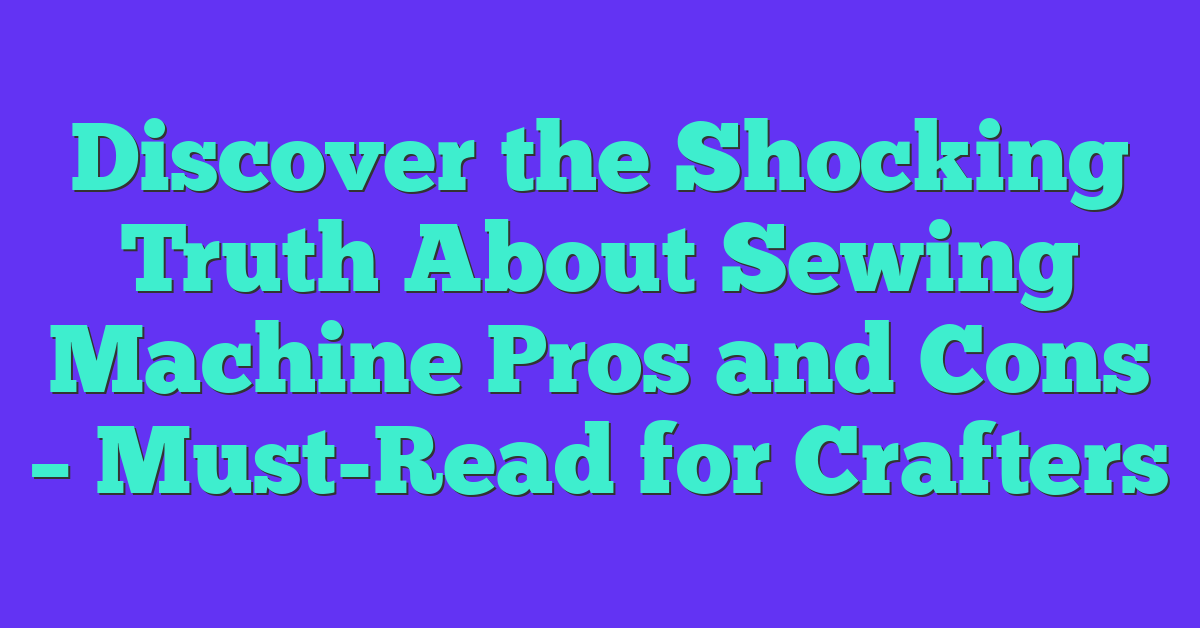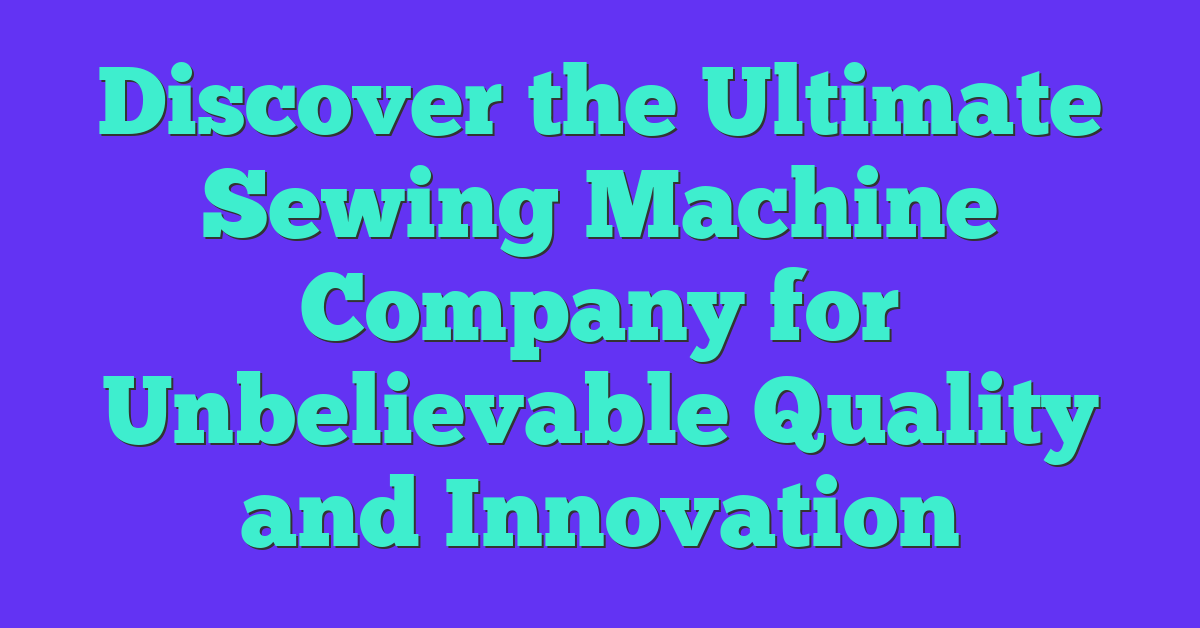Thinking about diving into the world of sewing? A sewing machine can be your best friend or a bit of a challenge, depending on how you look at it. Whether you’re a beginner or an experienced crafter, understanding the pros and cons of using a sewing machine can help you decide if it’s the right tool for your projects.
From speeding up your stitching to offering a variety of stitches, sewing machines have a lot to offer. But, like any tool, they come with their own set of challenges. Before you invest in one, let’s explore the benefits and drawbacks to ensure you make an informed decision.
Key Considerations Before Buying a Sewing Machine
Choosing a sewing machine involves several factors. This section will help you identify the critical aspects to consider before making your purchase.
Types of Sewing Machines
There are different types of sewing machines, each catering to specific needs.
- Mechanical Sewing Machines: Suitable for beginners, these machines are easy to use and require minimal maintenance.
- Electronic Sewing Machines: Offer advanced features and are perfect for those who wish to explore various stitches and sewing techniques.
- Computerized Sewing Machines: Ideal for complex projects, these machines come with programmable features and multiple stitch options.
- Embroidery Machines: Specifically designed for embroidery tasks, these machines can create intricate designs and patterns.
Factors to Consider: Cost, Build Quality, and Features
When purchasing a sewing machine, several factors must be evaluated.
- Cost: Determine your budget first. Sewing machines can range from $100 to over $5,000, depending on their features and brand.
- Build Quality: Check the materials used in the machine’s construction. Metal frames offer durability, while plastic parts may reduce weight but could be less robust.
- Features: Identify the features you need for your projects. Look for adjustable stitch length, buttonhole options, and a free arm for cuffs and sleeves. Advanced models might offer LCD screens, automatic thread cutters, and extensive stitch libraries.
Pros of Using a Sewing Machine
Sewing machines offer numerous benefits to both novice and seasoned crafters. They can help streamline your sewing projects and provide professional results. Here are some key advantages.
Efficiency and Speed
Sewing machines significantly improve efficiency and speed in your sewing projects. They stitch much faster than hand sewing, allowing you to complete projects in less time. For example, while a basic manual stitch might take several minutes by hand, a sewing machine can accomplish it in seconds. This is particularly useful for larger projects like quilts or garments.
Versatility in Projects
Using a sewing machine enhances the versatility of your craft projects. It enables you to work on a wide range of projects, from simple repairs to complex garment construction. For instance, you can easily switch between different types of stitches such as zigzag, straight, and decorative stitches. This versatility opens up creative opportunities, letting you explore various fabrics and techniques without much hassle.
Advanced Features and Automation
Modern sewing machines come with advanced features and automation that make sewing easier and more precise. Many machines offer programmable stitch patterns, automatic thread cutters, and adjustable stitch lengths. For example, computerized models can memorize needle positions and stitch sequences, allowing for consistent and accurate results. Features like automatic buttonholes and embroidery functions add further convenience and creativity to your projects.
By leveraging these advantages, you can significantly enhance your sewing projects, making them more efficient, versatile, and precise.
Cons of Using a Sewing Machine
While sewing machines offer incredible benefits, several drawbacks also exist.
Initial Cost and Maintenance
Purchasing a quality sewing machine often involves a significant upfront cost. Advanced models with features like programmable stitches and automatic thread cutters range from $200 to over $1,000. Beyond the initial expense, regular maintenance is essential. Machines need periodic cleaning, oiling, and occasional part replacements. These maintenance tasks, if neglected, can lead to costly repairs or reduced machine lifespan.
Learning Curve for Beginners
For beginners, using a sewing machine can be daunting. You must first get familiar with its numerous parts and functions, such as threading the needle, setting the tension, and selecting the correct stitch. Missteps can result in thread jams, uneven stitching, or fabric damage. Consequently, many novices find learning to operate a sewing machine challenging and time-consuming.
Space Requirements
Sewing machines occupy significant space. You need a dedicated area for the machine itself and additional room for related supplies like fabric, threads, and accessories. If you possess a smaller living space, the required setup for a sewing machine and its accessories might pose a challenge, making it inconvenient for those with limited room to spare.

By considering these aspects, you can better understand the potential drawbacks in the context of your specific crafting needs.
How to Make an Informed Decision
Selecting the right sewing machine requires understanding your specific needs and comparing available models and brands.
Evaluating Your Sewing Needs
Identify the primary types of projects you’ll undertake. For instance, quilting, garment construction, and embroidery each require different machine capabilities. Assess how frequently you’ll use the machine. If used daily, a durable, higher-end option might be best. Consider the complexity of features you desire. Beginners may benefit from machines with user-friendly interfaces and basic stitch options, while advanced users might prefer models with programmable features and extensive stitch libraries.
Comparing Different Models and Brands
Research various sewing machine brands like Brother, Singer, and Janome. Each offers unique strengths. Compile a list of essential features such as automatic needle threader, drop feed, and stitch variety. Compare machines within your budget range. Read reviews and testimonials to gauge reliability and user satisfaction. Check for warranty coverage and customer service quality. Some brands may offer extended warranties or better support.
By evaluating your needs and comparing different models and brands, you can make an informed decision. Choose a machine that fits your projects and budget, ensuring a rewarding sewing experience.
Conclusion
« Transform Your Sewing Space: Expert Tips on How to Put Your Sewing Machine in a Cabinet Efficiently
10 Must-Have Items on Your Sewing List for Beginners – You’ll Wish You Knew Sooner »
Choosing the right sewing machine can make a world of difference in your crafting journey. By understanding your specific needs and comparing different models and brands, you’ll be well-equipped to find a machine that fits your budget and skill level. Remember to consider essential features and read user reviews to ensure you get the most out of your investment. Happy sewing!












